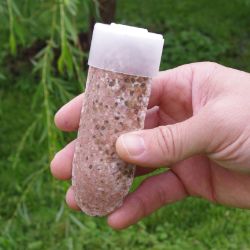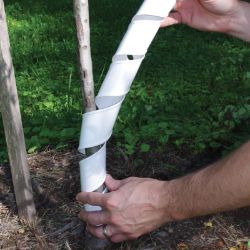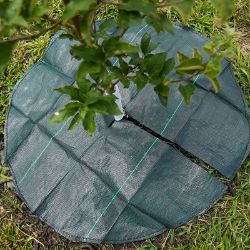Planting Pawpaw Trees
Successfully establishing a young fruit tree in your yard starts with your planting site and method. Once a fruit tree is established, it needs little assistance to grow and bear fruit; but you’ll want to make sure you give your trees the right foundation.
Stark trees that are grown and shipped in bottomless pots are part of our continuing quest for producing better and stronger trees for the home grower. By following these simple instructions, you will be assured of getting your young tree off to the best possible start.
NOTE: This is part 4 in a series of 10 articles. For a complete background on how to grow pawpaw trees, we recommend starting from the beginning.
Fruit trees require fertile soil for good growth, so before you plant, check your soil pH. Contact your local County Extension Office for information about soil testing in your area, or purchase one of our digital meters for quick and accurate results. Pawpaw trees enjoy a soil pH of 5.5-7.0. Steer clear of soils that are extremely heavy or poorly drained.
Before Planting
- When your tree arrives, carefully take it out of the package, making sure not to damage any of the branches. The potted tree has been watered prior to shipment and should arrive moist, but it does need another drink when it arrives at your home. Be sure the container is moist clear through. If you can’t plant your tree immediately upon arrival, keep the pot moist until you can plant it and keep the tree in a sheltered location. DO NOT place your potted tree in a bucket of water. This could cause the roots to rot, and kill your tree.
- Your tree is ready for planting as soon as it arrives at your home. Simply grasp the sides of the container and carefully slide the tree out. The potting soil should remain intact around the tree’s roots. You will want to keep this soil with the tree and plant it, soil and all, into the prepared hole.
- The first year is critical for a pawpaw. Protection from direct sun by shading the first few growing seasons is highly recommended. Use a wooden shingle, evergreen bough, or a screen with mini fence or similar method to provide shade. Plant two different varieties to assure proper pollination.
Planting Steps
- Space your trees 15-25 feet apart, depending on variety.
- Dig the hole deep and wide enough so the root system has plenty of room. (Keep the topsoil in a separate pile so you can put it in the bottom of the hole, where it’ll do the most good.)
- Roots grow better in soil that’s been loosened, so mix in our Coco-Fiber Potting Medium into your pile of topsoil. You can also use dehydrated cow mature, garden compost or peat moss (up to 1/2 concentration).
- Plant the same depth as grown in nursery row or in pot.
- Fill the hole, putting the topsoil back in first. You can avoid creating air pockets by working the soil carefully around the roots and tamping down firmly.
- Create a rim of soil around the planting hole 2” above ground level. This allows water to stand and soak in. (In the fall, spread soil evenly around tree to prevent damage from water freezing around the plant.)
Post-Planting
- Fertilize sparingly with Stark® Tre-Pep® Fertilizer. (If planting in the fall, wait to fertilize until spring for best results.) This effective starter fertilizer helps trees and plants grow quickly and vigorously. After watering, if soil compacts, be sure to add enough soil to fill the hole to ground level.
- No pruning is necessary at planting time.
Pollination
A pawpaw’s flowers have both male and female reproduction parts, but they are not self-pollinating. Also, the female stigma may mature and no longer be receptive when the male pollen is shed. They do require cross-pollination from another pawpaw tree. Bees have little interest in pawpaws; flies and beetles can do some pollination. The best solution is to pollinate by hand. Male pollen is ripe when the ball of anthers is brownish in color and loose. When collected, pollen grains will appear as small, beige-colored particles on the hairs of an artist’s brush. The female part of the flower is receptive when the tips of the pistils are green, glossy and sticky.

















